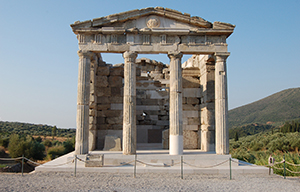Τόμος 4, Τεύχος 1 Ιανουάριος - Απρίλιος 2020 [σ. 6 - 23]
Αρχαία Μεσσήνη
Το Μαυσωλείο των Σαιθιδών
Πέτρος Θέμελης
Διευθυντής Ανασκαφών Αρχαίας Μεσσήνης - τ. Καθηγητής Κλασικής Αρχαιολογίας, Τμήμα Ιστορίας και Αρχαιολογίας, Πανεπιστήμιο Κρήτης
 Τα υλικά κατάλοιπα του παρελθόντος, όπως το εντυπωσιακό Μαυσωλείο της πανίσχυρης, οικονομικά και πολιτικά, μεσσηνιακής οικογένειας των Σαιθιδών, ειδικότερα μετά την πλήρη αναστήλωσή του με αυθεντικό πρωτογενές υλικό, αποτελούν ζωντανά μνημεία του σήμερα και όχι νεκρά απομεινάρια του χθες. Στην πορεία τους στον χρόνο αποκτούν νέο νόημα και αξίες, μεταλλάσσονται σε προϊόντα του εκάστοτε παρόντος, του κοινωνικού γίγνεσθαι. Οι επισκέπτες θεατές συγκροτούν την «αγορά», όπου σχολιάζονται και συζητούνται τα μηνύματα που εκπέμπει το δημιούργημα του παρελθόντος. Στη συζήτηση (περί των μηνυμάτων) παίζουν ρόλο το ιστορικό του μνημείου, η θέση του στον χώρο, η μορφή του, ο δημιουργός και ο κάτοχος.
Τα υλικά κατάλοιπα του παρελθόντος, όπως το εντυπωσιακό Μαυσωλείο της πανίσχυρης, οικονομικά και πολιτικά, μεσσηνιακής οικογένειας των Σαιθιδών, ειδικότερα μετά την πλήρη αναστήλωσή του με αυθεντικό πρωτογενές υλικό, αποτελούν ζωντανά μνημεία του σήμερα και όχι νεκρά απομεινάρια του χθες. Στην πορεία τους στον χρόνο αποκτούν νέο νόημα και αξίες, μεταλλάσσονται σε προϊόντα του εκάστοτε παρόντος, του κοινωνικού γίγνεσθαι. Οι επισκέπτες θεατές συγκροτούν την «αγορά», όπου σχολιάζονται και συζητούνται τα μηνύματα που εκπέμπει το δημιούργημα του παρελθόντος. Στη συζήτηση (περί των μηνυμάτων) παίζουν ρόλο το ιστορικό του μνημείου, η θέση του στον χώρο, η μορφή του, ο δημιουργός και ο κάτοχος.
Λέξεις ευρετηρίου: Μαυσωλείο, οικογένεια Σαιθιδών, πόδιο, ηρωολατρεία, Αρχιερείς των Σεβαστών, Ελλαδάρχες της επαρχίας Αχαΐας, συγκλητικοί, ταφικά παιχνίδια
COPYRIGHT: © Θέματα Αρχαιολογίας, 2020 - ISSN 2653-9292
Επικοινωνία με τον συγγραφέα: pthemeles@gmail.com
Το πρωτότυπο άρθρο βρίσκεται στη βιβλιοθήκη του περιοδικού Θέματα Αρχαιολογίας
![]()
Αυτό το άρθρο χορηγείται με άδεια Creative Commons Αναφορά Δημιουργού-Μη Εμπορική Χρήση-Όχι Παράγωγα Έργα 4.0 Διεθνές .
Volume 4, Issue 1 January - April 2020 [pp. 6 - 23]
Ancient Messene
The Mausoleum of the Saithidae family
Petros Themelis
Director of Excavations at Ancient Messene - F. Professor of Classical Archaeology, Department of History and Archaeology, University of Crete, Greece
 An imposing monument in the form of a Doric temple with four columns on the front, architecturally and functionally connected with the Stadium, is identified with the Mausoleum of the powerful Saithidae family used from the first to the late second c. AD onwards, i.e. from Nero’s to Marc Aurel’s and Lucius Verus’s periods. It is built on a high rectangular podium that protrudes from the city wall as a bastion. The marble portrait bust of a military figure of the first c. AD is attached to the center of the pediment. The Mausoleum’s façade is facing north towards the Stadium’s race course. Among its scattered architectural members were included numerous marble fragments belonging to a sarcophagus with a reclining figure on it, a portrait of the Antonine period and other parts of its sculptural decoration. Bases of grave stelai, fragments of aediculae of various sizes, as well as funerary inscriptions were brought to light around the monument’s podium.
An imposing monument in the form of a Doric temple with four columns on the front, architecturally and functionally connected with the Stadium, is identified with the Mausoleum of the powerful Saithidae family used from the first to the late second c. AD onwards, i.e. from Nero’s to Marc Aurel’s and Lucius Verus’s periods. It is built on a high rectangular podium that protrudes from the city wall as a bastion. The marble portrait bust of a military figure of the first c. AD is attached to the center of the pediment. The Mausoleum’s façade is facing north towards the Stadium’s race course. Among its scattered architectural members were included numerous marble fragments belonging to a sarcophagus with a reclining figure on it, a portrait of the Antonine period and other parts of its sculptural decoration. Bases of grave stelai, fragments of aediculae of various sizes, as well as funerary inscriptions were brought to light around the monument’s podium.
Key words: Mausoleum, Saithidae family, podium, herocult, High Priests of the Sebastoi, Helladrchs of he province Achaia, senators, funerary games
COPYRIGHT: © Themes in Archaeology, 2020 - ISSN 2653-9292
Author for correspondence: pthemeles@gmail.com
The original article is in the Library of the Themes in Archeology
![]() Creative Commons Attribution-NonCommercial-NoDerivatives 4.0 International .
Creative Commons Attribution-NonCommercial-NoDerivatives 4.0 International .
Διαβάστε το άρθρο Ανάτυπο PDF
Το πρωτότυπο άρθρο βρίσκεται στη βιβλιοθήκη του περιοδικού Θέματα Αρχαιολογίας
![]() Αυτό το άρθρο χορηγείται με άδεια Creative Commons Αναφορά Δημιουργού-Μη Εμπορική Χρήση-Όχι Παράγωγα Έργα 4.0 Διεθνές .
Αυτό το άρθρο χορηγείται με άδεια Creative Commons Αναφορά Δημιουργού-Μη Εμπορική Χρήση-Όχι Παράγωγα Έργα 4.0 Διεθνές .
